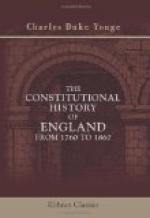“for constructive treason.” It must
therefore, probably, be affirmed that these two acts,
the Treason Act and the Seditious Meetings Act, went
beyond the necessity of the case; that they were not
only violations of the constitution—which,
when the measures are temporary, as these were, are
not always indefensible—but that they were
superfluous, unjust, and impolitic; superfluous, when
they proposed to deal with acts already visitable
with punishment by the ancient laws of the kingdom;
unjust, when they created new classes of offences;
and impolitic, as exciting that kind of disapproval
of the acts of government which in many minds has
a tendency to excite a spirit of discontent with and
resistance to legitimate authority. And, indeed,
it must be inferred that such was the light in which
these measures were regarded by a statesman who in
his general policy was proud to acknowledge himself
Mr. Pitt’s pupil, as he was also the most skilful
and successful of his more immediate successors.
Twenty-five years afterward the distress caused by
the reaction inevitably consequent on the termination
of twenty years of war produced a political excitement
scarcely inferior to that with which Pitt had now to
deal, and seditious societies and meetings scarcely
less formidable; but, as we shall see, Lord Liverpool,
taking warning, perhaps, from the mistake into which
Mr. Pitt was led on this occasion, though compelled
to bring forward new and stern measures of repression,
and even to suspend the
Habeas Corpus Act for
a time, kept strictly within the lines of constitutional
precedent, and was careful to avoid confounding sedition
with treason.
Notes:
[Footnote 73: He had been Lord-chamberlain in
Lord Rockingham’s administration of 1765.
He was now Lord-lieutenant of Ireland.]
[Footnote 74: In Lord Chatham’s or the
Duke of Grafton’s ministry of 1766, and in the
later administration of Lord Rockingham.]
[Footnote 75: It may be convenient to take this
opportunity of pointing out that, in this administration,
Lord Shelburne altered the old, most unreasonable,
and inconvenient arrangement by which the departments
of the two Secretaries of State were distinguished
by the latitude, and called Northern and Southern.
By a new division, one took charge of the home affairs,
the other of the foreign affairs. And in 1794
a third Secretary was added for War, who, by a very
singular arrangement, which continued till very recently,
had charge also of the colonies. But, in the
year 1855, the Colonial-office was intrusted to a separate
minister; and in 1858 a fifth Secretary of State,
that for India, was added, on the transfer of the
government of that country from the East India Company
to the Crown. When there were only two Secretaries
of State, the rule was that one should sit in each
House. At present it is not necessary
that more than one should be a peer, though it is more
usual for two to be members of the Upper House.
And it is usual also for the Under-secretaries to
be members of the House to which the Chief-secretaries
do not belong, though this rule is not invariably
observed.]




